By Roy Cook
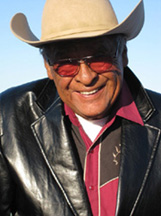 Auka, Wildcat
singer Jon Meza Cuero fulfilled all expectations September 25, 2010. He
was invited by the US Parks Point Loma Committee to be a Tribal representative
part of the 47th annual Cabrillo Day recognition. Superintendent Tom Workman
is there to greet us. He and Karl Pierce are familiar faces from the Parks
Service. All the singers: Jon, Ben Nance, Henry Medibles, Frank Gastelem
and Roy Cook, are pleased to be part of this Tribal recognition again.
Auka, Wildcat
singer Jon Meza Cuero fulfilled all expectations September 25, 2010. He
was invited by the US Parks Point Loma Committee to be a Tribal representative
part of the 47th annual Cabrillo Day recognition. Superintendent Tom Workman
is there to greet us. He and Karl Pierce are familiar faces from the Parks
Service. All the singers: Jon, Ben Nance, Henry Medibles, Frank Gastelem
and Roy Cook, are pleased to be part of this Tribal recognition again.

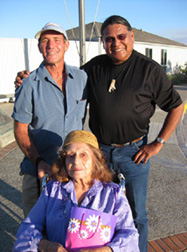 Jon
respectfully greets Tribal elder Jane Dumas and exchanges pleasantries
in Tipai. They are both linguistic colleagues and fluent native speakers
in the local dialect. A family member and Anthony Pico, former Chairperson
of the Viejas Band also accompanied Jane Dumas.
Jon
respectfully greets Tribal elder Jane Dumas and exchanges pleasantries
in Tipai. They are both linguistic colleagues and fluent native speakers
in the local dialect. A family member and Anthony Pico, former Chairperson
of the Viejas Band also accompanied Jane Dumas.
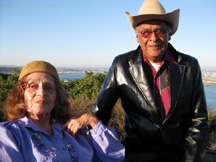 She
continues to demonstrate her commitment to this celebration again and
again. She participates in many of the activities that offer avenues to
tribal traditional ways. She is a very traditional tribal person. She
is truly an outstanding representative of the ongoing drama of tribal
Americans in a complex urban context. She has endured for many decades.
We are blessed each time we can be together.
She
continues to demonstrate her commitment to this celebration again and
again. She participates in many of the activities that offer avenues to
tribal traditional ways. She is a very traditional tribal person. She
is truly an outstanding representative of the ongoing drama of tribal
Americans in a complex urban context. She has endured for many decades.
We are blessed each time we can be together.
The wind blows free, the sun warms our backs, the rocks remain and the
songs sound again. We can look out across the bay and see the location
of the historical event carried by the songs selected by Jon Meza Cuero.
We are convinced there are ancient ears listening to the songs. Our goal
is to comfort and entertain all past, current and future peoples who hear
these timeless Niemii songs. Jon's selection of songs is particularly
appropriate to the occasion and, as explained to those gathered, are timeless
in the location and meaning of the songs presented.
But, once again, at this year festival, there are a couple of questionable,
curious references that got my 'goat'.
One, the dating of this festival as the 47th annual. I had read a Journal
of San Diego account of the first Cabrillo festival in downtown San Diego
in 1892. From that date to today is 118 years.
Two, at first contact, the term, fearful or great fear is quoted, as a
description of the appearance of members of the Kumeyaay people. The truth
is the local Indian people already knew of the Spanish. They were frightened
of the Spanish because of a series of violent encounters with an inland
Spanish army, looking for the cities of gold, led by Coronado. The local
Tribal people knew from, the eons earlier established American Indian
message runners communication system. Additionally, the sailors were suffering
from scurvy. It is a nasty, physically debilitating maritime disease.
The sailors' 'walking dead' pasty appearance would cause anyone to recoil
with apprehension.
The European summary of Cabrillo's journey in 1542 described the first
encounter of Spaniards and native peoples in this uncharted land. As the
story goes the Europeans approached the beach in a skiff where native
canoes could be seen and MANY Indians gathered. The Kumeyaay "gave
signs of great fear" as they physically described the sightings of
other Europeans by the interior Yuman peoples to Cabrillo and his party,
which was most likely a detachment from the expedition of Francisco Vasquez
de Coronado's exploration party into the New Mexico and Arizona interior.
The Indians indicated that these bearded men carried lances, rode great
horses, and brutally slaughtered many Indians. To assuage their fears,
Cabrillo and his men kidnapped two Indian boys and bribed the leaders
with more gifts. This documented above account verifies this writer's
position of prior American Indian knowledge of the Europeans and the message
system.
With mutual suspicion and violence, the opening page of history in California
began with cautionary actions by both Native Californians and the Spanish.
The Kumeyaay attacked first, perhaps, to protect them and repel the unwanted
visitors, hopefully escaping the fate of the Colorado River Yumans killed
by the soldiers of Coronado. The Spanish, led by Cabrillo, initially chose
restraint (probably because of the weak condition of its scurvy-ridden
crew) so that they might persuade the Indians of Alta California to accept
the imperatives of Spanish culture and religion. From this documented
account, we can conclude there is NO clear legal or just claim for European
imperial colonization. Resistance would continue into the next century
and beyond. Aboriginal land title would continue to rest with the Native
Tribal people.
The first Cabrillo festival 1892 (San Diego Journal Summer 1984, excerpt)
Earliest mention of a civic event to promote the historical significance
of San Diego as the birthplace of California was made by Walter G. Smith.
He was the editor of The Sun and he urged city fathers to promote the
area by holding a celebration. The event would commemorate navigator Juan
Rodriguez Cabrillo's discovery of San Diego Bay three hundred fifty years
before on September 28, 1542. The celebration would afford citizens the
opportunity of acquainting visitors with the city's attributes.1
Although Smith's idea lay dormant until July 16, 1892, when San Diego
Mayor Mathew Sherman called together a large number of prominent interested
citizens, the group moved quickly to expedite plans for the celebration.
Smith pointed out that this seemed to be an appropriate time to celebrate
Spain's discovery and that it would be wise for San Diego to take the
lead as the birthplace of Alta California. Mayor Sherman then appointed
a general committee to formulate ideas for the festivities and in turn
to select subcommittees to work toward the promotion of activities through
the development of a guest list of very important people.2

Elisha S. Babcock, manager of the Hotel del Coronado, offered to contribute
one-tenth of the cost of bringing an Indian tribe to entertain visitors.3
Fundraisers set their goal at $5,000 and began their appeal for financing
the celebration. They hoped to secure $1,000 from the city and county.4
with the expectation that the celebration would "attract the attention
of the entire country to the remarkable inducements for investments .
. .",5 the common council allocated $500. They also felt the press
would prove highly beneficial with heavy coverage providing wide exposure
for the events.6 By calling attention to the area, the press had the ability
to attract many visitors and potential residents to city and county business,
agricultural, and commercial attributes.7
Rapid response to invitations made planning easier. Both the Diegueno
and Luiseno Indian tribes told Father Antonio Ubach they would be anxious
to participate for their food and expenses. According to The Sun, the
"bucks and squaws" planned to wear costumes of olden times while
singing, dancing and playing their ancient, native games. The Indians
for the construction of their huts.8 would use tule from Mission Valley
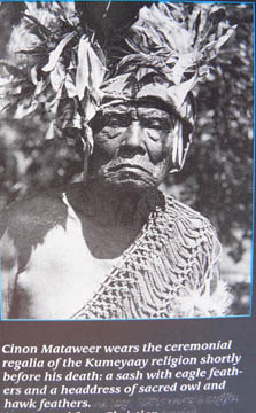 A letter
from Mesa Grande to Father Ubach from two Diegueno chiefs of the Antonio
La Chapa and Cinon Duro. The tribes reported that the young Indians, in
their many hours of daily practice to defeat the Luisenos in dances and
games, had developed sore feet.1
A letter
from Mesa Grande to Father Ubach from two Diegueno chiefs of the Antonio
La Chapa and Cinon Duro. The tribes reported that the young Indians, in
their many hours of daily practice to defeat the Luisenos in dances and
games, had developed sore feet.1
Beginning with the Indians on opening day, the program could now accommodate
vaquero or cowboy games and exhibitions on the closing day.19
The excitement began to mount as the people observed a pavilion, covering
a ground space of 200 x 125 feet, with a framework of poles and ropes
centered by an eighty-foot pole supporting a fifty-foot evergreen canopy
being erected in the Plaza. Enclosed by a high board fence, it was more
difficult to view the Indians constructing their tule huts around the
inner portion of their 200 x 300 foot allocated area on A and Fourth Streets.
A 125-foot central circle provided space for their dances and games.20
The Luiseno Indians from Oceanside preferred to walk rather than ride
in cars to San Diego.21
Flying the Spanish flag, the landing party stepped smartly from the ship's
boat to a gangplank. They proceeded on to the land where they planted
the flag and, in the name of King Charles V of Spain, Cabrillo took possession
of the country.40
As a part of the ceremony, Cabrillo greeted six Indian chiefs: General
Mateo Pia of Patchanga, Pedro Pablo of Panama, Vicente of Temecula, Jose
Manuel of Santa Ysabel and Cinon and Narcison of Mesa Grande. He talked
to them in his native language (Portuguese) while they knelt and kissed
the ground.41
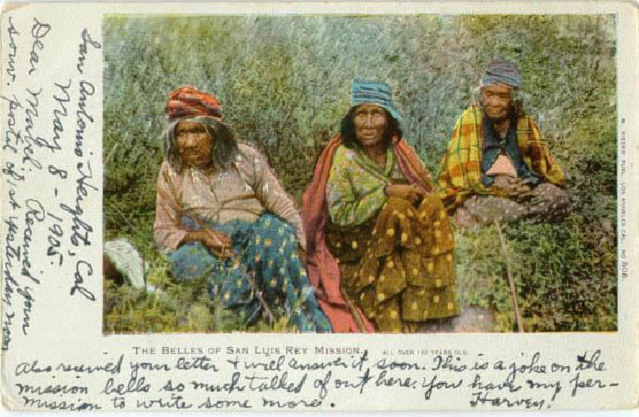
The Indians appeared quite primitive and picturesque in their colorful costumes consisting mostly of body paint and feathers, and abbreviated G-string apron-like garments. Although their native attire may have embarrassed the spectators, the Indians remained stoic and indifferent to any criticism.4
Among the well over fifteen hundred people who joined them parading up
D Street through the town were:
Diegueno and Luiseno Indian tribe representatives, men attired in black
and white calico, most with hats, women in bright calico heavily trimmed
with ribbons; some men stripped to the waist, with their exposed parts
painted bizarre colors while wearing Indian headdresses fashioned from
grain stalks, ferns, leaves and mountain roses; various dignitaries in
open carriages; more Indians in native costumes.
By day, the Indians arranged the costumes for their fiesta activities,
which consisted of games, and dances.52 the preparation involved covering
their bodies and faces with ninety-nine colored clays. After the task
was completed, war paint was prepared and applied by the women. To achieve
the right consistency for the paint mixture, the women chewed one or two
colors, and then spit the combination on the designated area of the man's
body. In the final step, they proceeded to fashion the paint decoration
in stripes and geometrical patterns. The men wore head dresses made of
tule, horsehair, fur, snakeskins, feathers and bird wings. They carried
rattlesnake rattles, crude weapons and bows and arrows. The women dotted
their faces with the paint concoction and wore brilliant ribbons.53 following
the Thursday afternoon speeches in the Plaza; the Indians presented their
fiesta.54
Unfortunately, there had been no arrangements made for witnessing the
event. There was no way to control the squeezing, pushing and cursing,
both loud and muttered, by those in the crowd who anxiously sought a better
vantage point. Consequently, most had a poor view of the sports with the
exception of an occasional glimpse of waving feathers.55
While one man kept time with rattles contained in large pot-like in-struments,
the colorful warriors moved slowly, shoulder to shoulder, around the circle
in the center of the stockade. Their chanting with a range of about three
notes was slow and continuous. From time to time, the musician let out
a loud "ugh!" which prompted an Indian "yell" from
the entire tribe. Then a heavily painted and feathered, agile brave would
whirl around the center of the ring. Generally speaking, the Luiseno men
and women were larger and had finer features than the Dieguenos. Luiseno
men also had the appearance of being fine athletes.56
Who was this Hombre, Cabrillo?
Juan Rodríguez Cabrillo, who died in 1543 while attempting to complete
the first exploration California's coastline,
Though he is generally supposed to have been Portuguese, the evidence
is too scanty to be sure. His birthplace and origins are shrouded in mystery
and controversy, and scholars still debate whether he is from Spain or
Portugal.[1] The name Cabrillo was first mentioned in 1536 and in most
Spanish archives, he is listed as Joao Rodriques Cabrilho (a name spelled
with an "H"). In his younger life, he is simply referred to
as Juan Rodriquez, which is just about as common as John Smith nowadays.
Typically, in the 16th century, a surname was later given to emigrants
in the New World, and it was usually derived from the town, region or
province from which they came.
According to Kelsey, Portuguese historian Cestino Soares insists that
the explorer is from Portugal, but acknowledges that the name Cabrillo
is not known in Portugal. There are, however, several towns, rivers and
mountains named Cabril, and they are often described in the Spanish feminine
adjectival form such as Cabrilla, Cabrillas and Cabrillanes. But they
are never called Cabrillo or Cabrilho.
Manuel Macias, who teaches the history of Latin America at Cabrillo, read
Kelsey's book and was convinced that Cabrillo was of Spanish descent.
"What his grandson said should be proof enough," Macias said.
Macias was referring to sworn testimony given by Cabrillo's grandson,
Geronimo Cabrillo de Aldana, Dec. 4, 1617. Aldana proclaimed then, "My
paternal grandfather, Juan Rodriquez Cabrillo came (to the New World)
from the Kingdoms of Spain in the company of Panfilo de Narvaez."
What did he do to serve his country and his lord?
Cabrillo first arrived in the New World in Jamaica and then traveled with
Narvaez to Cuba in 1511 joining a force of several hundred Spanish soldiers
who were led by Diego Velazquez, later made the first Spanish governor
of Cuba. The Spanish were claiming the island for the kingdom of Spain.
Narvaez led a cuadrilla of 30 crossbowmen, each served by a Jamaican slave.
Kelsey believes Cabrillo went on the mission with Narvaez, who pursued
a bloody, grisly march into the interior of Cuba.
According to Kelsey, the chaplain who accompanied the Narvaez expedition,
Bartolome de las Casas, was horrified by Narvaez's slaughter of the Indians.
Las Casas charged Narvaez himself with killing 2,000 Indians and said
countless others were killed by the horsemen and foot soldiers bearing
swords and crossbows. Kelsey wrote:
"One evening after a long and thirsty march in the interior, Narvaez
and his army arrived at the village of Caonao, where the Indians greeted
them with food and calabashes of water. Thus refreshed, the Spaniards
were invited to enjoy a fish dinner prepared by the villagers. While the
soldiers ate, the natives looked on, examining the horses -- those peculiar
animals the Indians had only heard about but not seen -- and marveling
at the dress and equipment of the Spaniards. As the curious villagers
pressed closer, a soldier suddenly drew his sword and began hacking away
at the bystanders. This was a signal for all to join in the slaughter,
killing young and old, men and women, even domestic animals."
Las Casas, horrified by the scene, abandoned the expedition and said,
"You and your men can go to the devil."
Las Casas later documented the brutal encomienda system which granted
Spanish masters and other proprietors vast tracts of land in which the
residing natives were forced to pay annual tasaciones. These new rulers
were called encomenderos who collected taxes or "tributes" from
the indigenous people in the form of goods or services rendered. Encomenderos
were supposed to indoctrinate the indigenous people with Christianity
and provide protection from external enemies. If the native people refused
to pay the tasaciones or acknowledge Spanish authority, Las Casas said
they were branded as slaves and marched off to the many goldmines in 16th
Century Cuba.
In 1520 Cabrillo, serving as a crossbowman, arrived in Mexico with Narvaez.
The Spanish force was sent with the intent of replacing the renegade Hernan
Cortes, who left Cuba with 300 men to conquer Mexico without the crown's
permission. Using some trickery, Cortes outmaneuvered Narvaez's larger
force and absorbed Narvaez's troops with the promise of Aztec treasure.
Cabrillo was soon made a captain of a cuadrilla, and later served a vital
role in bringing about the fall of Tenochtitlan, the Aztec capital at
the site of present day Mexico City.
On June 27, 1542 Cabrillo headed north with three vessels: San Salvador,
which he captained and two others.
About August 20, they passed the most northerly point (Punta del Engaño)
reached by Ulloa. On September 28, three months after leaving Mexico,
the ships crossed the future international border and put into a "very
good enclosed port, to which they gave the name San Miguel." It was
our San Diego.
The Indians there were afraid. The Indians told Cabrillo of a large force
of Spaniards just a five-day walk away. They were frightened of the Spanish
because of a previous violent encounter with an inland Spanish army led
by Coronado. This army had wandered for two years, terrorizing the Southwest
and reaching far into the interior of the continent to present-day Kansas.
Cabrillo attempted to send a letter to Coronado via these Indians. That
evening they wounded, with arrows, three men of a fishing party. Instead
of marching forth in retaliation, Cabrillo sailed slowly on into the harbor,
caught two boys, gave them presents and let them go.
On Sept. 17, 1542, Cabrillo claimed California for the Spanish Crown.
"Every place he (Cabrillo) discovered, he was to take possession
for the king of Spain," said Macias. "All explorers were told
that when they encountered a new group of Indians, they were required
to read them this explanation, called a requerimiento. It was an act of
taking possession of the land."
Macias said the requerimiento was read in Spanish and Latin, neither of
which languages the Indians understood. A ritual ceremony was also performed:
four pebbles were tossed in four directions and water was spilled on the
land as a physical act of taking possession. Macias said the requerimiento
instructed the Indians to submit to Spanish authority under religious
justification as ordered by the pope.
The beginning of the letter, translated into English read: "On the
part of the King, Don Fernando, and of Dona Juana, Queen of Castile and
Leon, subduers of the barbarous nations, we their servants notify and
make known to you, as best we can, that the Lord our God, Living and Eternal,
created the Heaven and the Earth, and one man and woman, of whom you and
I, and all the men of the world, were and are descendants, and all those
who came after us. But, on account of the multitude which has sprung from
this man and woman in the five thousand years since the world was created,
it was necessary that some men should go one way and some another, and
that they should be divided into many kingdoms..."
There is no firm agreement about the cause or place of his death, up the
coast and most likely of gangrene read most conclusions.
________________________________________________________
Source: San Diego Journal, 1984: San Diego's First Cabrillo Celebration,
1892: Sally Bullard Thornton, 1984.
Biography of Cabrillo: Harry Kelsey, 1986.